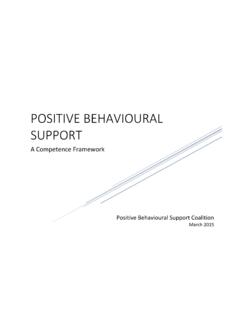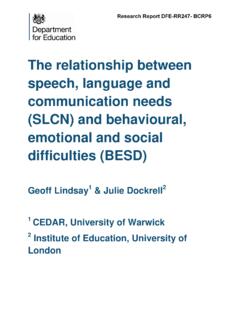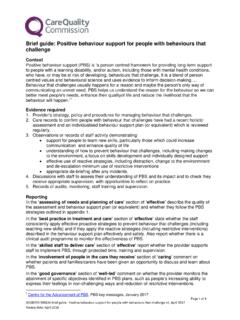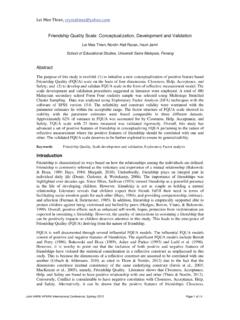Transcription of CLASSROOM SEATING AND ACHIEVEMENT Seating …
1 CLASSROOM SEATING AND ACHIEVEMENT . SEATING arrangements that promote positive academic and behavioural outcomes: a review of empirical research RACHEL WANNARKA and KATHY RUHL. SEATING arrangements are important CLASSROOM setting edgeable about setting events so that they can apply this events because they have the potential to help prevent knowledge to everyday CLASSROOM situations. problem behaviours that decrease student attention and diminish available instructional time. The purpose of A wide range of stimulus conditions fall into the category of CLASSROOM environmental variables and setting events. Some this synthesis of empirical literature is to determine of these conditions are temperature, lighting (Granstrom, which arrangements of desks best facilitate positive 1996), SEATING arrangement, noise level, and the presence or academic and behavioural outcomes for primary absence of peers or adults.
2 Of particular interest is SEATING through secondary high school students with a range of arrangement because variables related to SEATING arrange- characteristics. Eight studies that investigated at least ment, such as CLASSROOM position, have been shown to two of three common arrangements ( , rows, groups impact on educational interactions. or semi-circles) were considered. Results indicate that The physical arrangement of the CLASSROOM has the potential teachers should let the nature of the task dictate to encourage desirable behaviour or contribute to students'. SEATING arrangements. Evidence supports the idea that misbehaviour (Daniels, 1998). Additionally, unlike other students display higher levels of appropriate behaviour factors that also impact on behaviour ( , individual during individual tasks when they are seated in rows, student characteristics, social dynamics), SEATING arrange- with disruptive students benefiting the most.
3 Ment is one factor that is typically under teacher control. CLASSROOM arrangement significantly impacts on student behaviour, and there is evidence to suggest that it impacts on Key words: SEATING , ACHIEVEMENT , behaviour, research. ACHIEVEMENT as well (Pace and Price, 2005). Moore and Almost three decades ago, researchers began to call for Glynn (1984), for example, found that a student's location systematic investigations of the influences of antecedent and in the CLASSROOM is related to the number of questions structural events upon student performance ( , Weinstein, received from the teacher; this may influence the student's 1979). Often referred to as setting events or stimulus condi- opportunity to respond and thus to learn. Also, Granstrom tions, antecedent and structural events are of particular (1996), perhaps not surprisingly, found that students at the interest because manipulations of these may be considered back of the CLASSROOM tend to interact with each other more naturalistic interventions that unobtrusively alter behaviours.
4 Frequently than those seated at the front, potentially Interventions involving setting events can be easily incorpor- adversely impacting their attention to the task at hand. ated into the course of a school day and should aid in behavioural generalisation. Focusing on stimulus conditions Because proximity and orientation influence commun- rather than consequences may help teachers discretely to ication, it is possible that desk configuration impacts on the prevent problem behaviours before they occur and avoid nature and extent of student interaction. Thus it is important utilising unnecessarily intrusive interventions. Also, inter- for teachers to have the knowledge necessary to make ventions based on unnatural consequences are less likely to informed decisions about whether rows, clusters, semi- lead to behavioural generalisation than interventions that circles or some other arrangement will best meet the control naturally occurring reinforcers (Wheldall, Morris, instructional needs of their students.)
5 This may be especially Vaughan and Ng, 1981). Thus, teachers should be knowl- critical in inclusive settings that serve students with 2008 The Author(s). Journal compilation 2008 NASEN. Published by Blackwell Publishing, 9600 Garsington Road, Oxford OX4 2DQ, UK and 350 Main St, Malden, MA, 02148, USA. disabilities and those without disabilities concurrently, due room arrangement and SEATING arrangement resulted in a to the wide range of behavioural and academic characteris- much higher proportion of relevant articles. Finally, an tics represented. ancestral search was conducted using the references of the studies obtained using the above procedures and additional On examination of various texts ( , Paine, Radicchi, articles meeting the criteria were identified and included. Rosellini, Deutchman and Darch, 1983; Walker, Shea and Eight studies meeting the above criteria were identified Bauer, 2007) for recommendations pertaining to SEATING through this process.
6 Arrangements, it seems that there is a lack of consensus to guide teachers as they seek to make good decisions about the best arrangement to use for their students. The purpose of this Results synthesis of the literature is to summarise empirical studies that investigate either academic or behavioural outcomes as a The studies identified for inclusion in this review all used result of different SEATING arrangements. Student behavioural SEATING arrangement as an independent variable with rows ( , disruptive') and academic ( , high-achieving') as a condition. In most cases, rows were compared to aggre- characteristics are considered within this context. gations of desks ( , clusters, tables or groups) that are collectively referred to here as groups.' Two studies also compared rows to a circular arrangement (Marx, Furher and Method Hartig, 2000; Rosenfield, Lambert and Black, 1985).
7 All but two studies (Bennett and Blundell, 1983; Marx, Furher and Inclusion criteria Hartig, 2000) were concerned with identifying changes in on-task behaviour as a result of the SEATING arrangements Articles had to meet the following criteria to be included in imposed, though definitions of on-task' varied considerably the synthesis: (a) the article described an empirical study in between the studies. Marx and colleagues studied student which desk arrangement served as an independent variable;. question-asking; Bennett and Blundell focused on the quan- (b) subjects had to be of school age ( , nursery through tity and quality of work output. 12th grade); and (c) the articles had to be available in English and published in a peer reviewed journal between 1979 and 2007 (inclusive). Articles were not excluded based Participants ranged in age from 7 to 15 years old, though 9-, upon the country in which the study was conducted.
8 10- and 11-year-olds were the subjects of six of the eight studies. Effects of a rows SEATING arrangement on the various student behaviours are summarised in Table 1. Search procedures Searches of two educational databases ( , ERIC and SEATING arrangement impact on student on-task Wilson) and one psychological database ( , PsychInfo) behaviour were conducted. All three databases were searched using room arrangement, CLASSROOM arrangement, desk arrange- The studies that concerned individual tasks were unequivo- ment, and SEATING arrangement as keywords. A large cal in their support for a rows arrangement to increase number of irrelevant articles were identified on PsychInfo so on-task behaviour and/or decrease off-task behaviour when the procedure for that database was refined. Eliminating students were expected to work on their own. What consti- Table 1.
9 Effects of a rows SEATING arrangement on student behaviour in individual and interactional tasks Article Students Type of task Outcome of rows Age Additional characteristics Axelrod, Hall and Tams, 1979 7 8 academically behind' Individual Increased OTB. Bennett and Blundell, 1983 10 11 Individual Work production increased, quality maintained Hastings and Schweiso, 1995 7 8 Individual Increased class OTB. Hastings and Schweiso, 1995 9 11 3 target boys were disruptive' Individual Increased class OTB;. dramatic increase for target students Marx, Furher and Hartig, 2000 9 10 Interactive Decreased OTB. Rosenfeld, Lambert and Black, 1985 10 12 high' and low' ability Interactive Decreased OTB. Wheldall and Lam, 1987 12 15 Emotional, behavioural , and/or learning difficulties Individual Increased OTB. Wheldall, Morris, Vaughan and Ng, 1981 10 11 Students initially rated as high, medium, or low NTB; Individual Increased OTB.
10 One class considered boisterous'. Yeomans, 1989 7 8 Individual Increased OTB. Note: Dashes indicate that additional behavioural and academic characteristics were not provided. OTB = on-task behaviour defined as following teacher's directions (speaking only with permission, keeping hands to self, etc.) and attending to academic tasks. 90 Support for Learning Volume 23 Number 2 2008 2008 The Author(s). Journal compilation 2008 NASEN. tuted on- and off-task behaviour was defined by teachers or when the task is individual. Marx, Furher and Hartig (2000). researchers, so the particular behaviours of concern varied investigated the relationship between SEATING arrangements by activity across the studies. Examples of on-task behav- and the question-asking patterns of ten-year-olds. They iour were hand-raising and complying with requests, and found that students asked their teacher significantly more examples of off-task behaviour were talking out of turn or questions when they were seated in a semi-circle than in being out of seat without permission.










